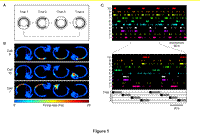

Research in our laboratory
focuses on the study of the formation and maintenance of memories within the
hippocampus and neocortex. To study the basis of these processes, we employ
a combination of molecular genetic, electrophysiological,
pharmacological, behavioral, and computational approaches. In particular,
we use a technique that allows us to record simultaneously the activity of
ensembles of hundreds of single neurons in freely behaving animals.
These studies have led to the exploration of the nature of sleep and its role in memory. Previous theories have suggested that sleep states may be involved in the process of memory consolidation, in which memories are transferred from short to longer-term stores and possibly reorganized into more efficient forms. Recent findings have identified explicit correlates of dreaming during periods of rapid eye movement (REM) sleep. By reconstructing the content of these states, specific memories can be tracked during the course of the consolidation process.
Simultaneous monitoring of areas in the hippocampus and neocortex has allowed us to study the downstream effects of activation. Recent experiments have demonstrated a relationship between the activity of the hippocampus during awake and sleep states, and activity within the prefrontal cortex, a neocortical region involved in higher cognition, decision-making, and memory. Recent recordings in the entorhinal cortex have revealed responses dependent upon future behavioral trajectory as well as reflecting generalization across tasks and environments.
Combining the measurement
of ongoing neuronal activity with manipulation of molecular genetic targets
in the hippocampus and neocortex has allowed us to study how specific cellular
mechanisms regulate neural function to produce learning and memory at the
behavioral level. Taken together, these approaches contribute to the overall
research objective: to understand the link from cellular/subcellular mechanisms
of plasticity, to neural ensemble representations and interactions, to learning,
memory, behavior, and cognition.


Activity recorded from 10 hippocampal place cells during the circular maze task shown in panel A. Panel B shows examples of place fields. Panel C shows the unique signature of unit activity over time for the task. These patterns are replayed during subsequent REM sleep.

Picower Scholar Associate
Professor, Departments of Brain and Cognitive Sciences and Biology
Investigator, RIKEN-MIT Neuroscience Research Center
Matthew A. Wilson
received his Ph.D. in Computational and Neural Systems from the California
Institute of Technology and completed his postdoctoral training at the University
of Arizona. In 1994, he joined the faculty of the Departments of Brain and
Cognitive Sciences and the Picower Center for Learning and Memory at MIT.
Dr. Wilson is the recipient of the Alfred P. Sloan Foundation Fellowship,
John Merck Scholar Award and Middleton Neurosciences Award from the MIT School
of Science, and the Office of Naval Research Young Investigator Award.
 |